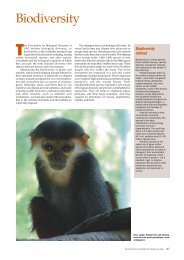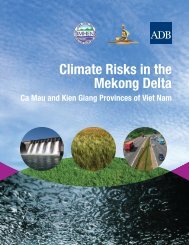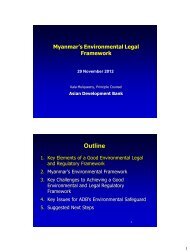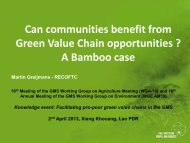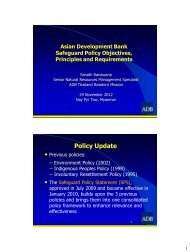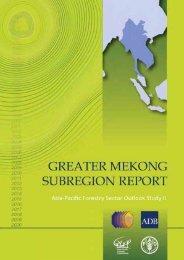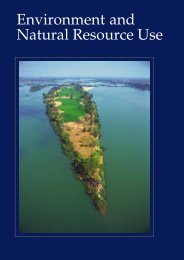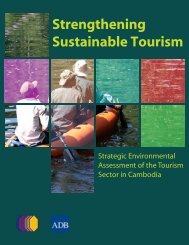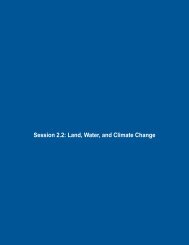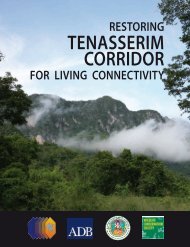Agricultural Land in the GMS (thousand hectare) in ... - GMS-EOC
Agricultural Land in the GMS (thousand hectare) in ... - GMS-EOC
Agricultural Land in the GMS (thousand hectare) in ... - GMS-EOC
You also want an ePaper? Increase the reach of your titles
YUMPU automatically turns print PDFs into web optimized ePapers that Google loves.
Empty<strong>in</strong>g waste <strong>in</strong>to a householdbiogas collector, also known as ananaerobic digester, Cambodia.Total Potential and InstalledHydropower Capacity <strong>in</strong> <strong>the</strong> <strong>GMS</strong>(megawatt)<strong>GMS</strong> Country Installed Capacity PotentialCambodia 13 5,000–8,600People’s Republic of Ch<strong>in</strong>aGuangxi 25,100 78,800Yunnan 11,980 90,000Lao PDR 1,826 23,000Myanmar 2,521 100,000Thailand 3,424 10,000Viet Nam 4,155 15,000TOTAL 49,019 248,000<strong>GMS</strong> = Greater Mekong Subregion, Lao PDR = Lao People’s Democratic Republic.Source: ADB. 2008. Integrat<strong>in</strong>g Biofuel and Rural Renewable Energy Production <strong>in</strong>Agriculture for Poverty Reduction <strong>in</strong> <strong>the</strong> Greater Mekong Subregion: An overview andStrategic Framework for Biofuels Development. Manila; ADB. 2008. Energy Sector <strong>in</strong><strong>the</strong> Greater Mekong Subregion. Manila; Lao PDR. 2010. Brief<strong>in</strong>g on Lao PDR PowerDevelopment Plan 2010 – 2020. Prepared for <strong>the</strong> <strong>GMS</strong> N<strong>in</strong>th Meet<strong>in</strong>g of <strong>the</strong> RegionalPower Trade Coord<strong>in</strong>ation Committee, October 2010. Shenzhen, PRC; Myanmar. 2010.Myanmar Brief<strong>in</strong>g. Prepared for <strong>the</strong> <strong>GMS</strong> N<strong>in</strong>th Meet<strong>in</strong>g of <strong>the</strong> Regional Power TradeCoord<strong>in</strong>ation Committee, October 2010. Shenzhen, PRC.Two thirds of <strong>the</strong> hydropower potential <strong>in</strong> <strong>the</strong><strong>GMS</strong> are <strong>in</strong> Myanmar and Yunnan, with smallerbut still substantial resources across <strong>the</strong> subregion.Hydropower is currently <strong>the</strong> ma<strong>in</strong> source for crossborderelectricity trad<strong>in</strong>g. The Lao PDR, for example,currently sells 1,881 megawatts of hydropowerto Thailand. Future development of hydropowercapacity will rely on significant expansion of crossborderelectricity trad<strong>in</strong>g. Also, small, low-impacthydropower plants, which have <strong>the</strong> potential tobe widely deployed throughout <strong>the</strong> <strong>GMS</strong>, couldprovide electricity access <strong>in</strong> rural areas.The development of hydropower resources isnot without costs. Large plants could reduce <strong>the</strong>availability of water resources, displace peoplefrom <strong>the</strong>ir land, and disturb ecosystems. There isalso a strong perception that <strong>the</strong> plann<strong>in</strong>g process isskewed toward favor<strong>in</strong>g <strong>the</strong> broader economic ga<strong>in</strong>sfrom hydropower plants over <strong>the</strong>ir environmentalimpact. An environmental assessment frameworkthat is <strong>in</strong>tegrated <strong>in</strong>to <strong>the</strong> plann<strong>in</strong>g process wouldprovide a way to manage and mitigate <strong>the</strong> negativeimpacts of hydropower development.Biomass and Biogas. Numerous renewable energysources are available with<strong>in</strong> <strong>the</strong> <strong>GMS</strong>. Biomass,especially <strong>in</strong> <strong>the</strong> form of fuelwood, rema<strong>in</strong>s <strong>the</strong>major source of energy for light<strong>in</strong>g and heat<strong>in</strong>g <strong>in</strong>most of <strong>the</strong> <strong>GMS</strong> (except Thailand), particularly <strong>in</strong>rural areas. In 2005, <strong>the</strong> share of biomass <strong>in</strong> <strong>the</strong> totalprimary energy supply was 26%, though down from31% <strong>in</strong> 2000. Biomass is used by over 50% of <strong>the</strong>rural population <strong>in</strong> Viet Nam, 83% of households<strong>in</strong> Cambodia, 80% of households <strong>in</strong> <strong>the</strong> Lao PDR,and 93% of rural households <strong>in</strong> Myanmar. InYunnan, almost 41% of rural households are totallydependent on firewood for cook<strong>in</strong>g. In Thailand,77% of <strong>the</strong> 2,120 megawatts of renewable energycapacity is fuelled by biomass, such as rice husks,bagasse, and wood and o<strong>the</strong>r agricultural residues.The use of forest biomass resources hasseveral implications for energy security andenvironmental susta<strong>in</strong>ability <strong>in</strong> <strong>the</strong> subregion.Poor households often spend a significantamount of <strong>the</strong>ir <strong>in</strong>come on fuelwood orcharcoal. Forest resources are important forbiodiversity and are also a source of livelihoodfor many people <strong>in</strong> rural areas. Forest resourceshave decl<strong>in</strong>ed steadily over <strong>the</strong> last two decades,aggravat<strong>in</strong>g social and economic vulnerabilitiesof <strong>the</strong> rural population.Biogas can provide rural households withmodern light<strong>in</strong>g and heat<strong>in</strong>g. As a cheap, cleaneralternative to biomass, biogas could reducepressure on forest resources. The PRC’s biogasdevelopment <strong>in</strong>itiative is <strong>the</strong> most extensive<strong>in</strong> <strong>the</strong> <strong>GMS</strong>: approximately 26.5 million ruralhouseholds deploy biogas facilities that generateabout one billion cubic meters of methane. Thetechnology is be<strong>in</strong>g extended to o<strong>the</strong>r <strong>GMS</strong>countries through pilot projects supported by <strong>the</strong>Government of <strong>the</strong> Ne<strong>the</strong>rlands.Biofuels. Spurred by strong national programs,biofuels are rapidly emerg<strong>in</strong>g as an importantenergy source for <strong>the</strong> <strong>GMS</strong>. The PRC (as a whole)ranks as <strong>the</strong> third largest producer of bioethanol<strong>in</strong> <strong>the</strong> world. With<strong>in</strong> <strong>the</strong> PRC, Guangxi producesethanol from cassava at one of <strong>the</strong> PRC’s five ma<strong>in</strong>bioethanol plants; Yunnan is a demonstrationprov<strong>in</strong>ce for biodiesel from jatropha. Thailandranks as <strong>the</strong> eighth largest producer of biofuels.Between 2000 and 2009, transport energy demand<strong>in</strong> <strong>the</strong> <strong>GMS</strong> (exclud<strong>in</strong>g PRC) <strong>in</strong>creased 50%.The high dependence on oil imports is likely torema<strong>in</strong> as demand cont<strong>in</strong>ues to outpace domesticproduction. Future demand for oil accounts forapproximately 40% of <strong>the</strong> <strong>in</strong>crease <strong>in</strong> total energyconsumption through 2025. Biofuels providean alternative to oil products, reduc<strong>in</strong>g importvulnerabilities and offer<strong>in</strong>g an environmentallybenign energy option for <strong>the</strong> fast grow<strong>in</strong>gtransportation sector.Biofuels also offer a strong developmentdividend. They provide new markets for exist<strong>in</strong>gagricultural products and could enhanceeconomic opportunities <strong>in</strong> <strong>the</strong> agricultural sector,which susta<strong>in</strong>s <strong>the</strong> majority of <strong>the</strong> subregion’spopulation. Biofuel produced from conversion of10% of <strong>the</strong> available land and wasted gra<strong>in</strong> coulddisplace up to 34% of <strong>the</strong> conventional transportfuel energy demand with biodiesel and even morewith bioethanol.Despite <strong>the</strong> potential, biofuel development is notwithout challenges. Experience suggests that ifdeployed unsusta<strong>in</strong>ably, biofuels can be associatedwith numerous risks. Increased demand forbiofuel feedstock like maize and cassava leads tocompetition with <strong>the</strong> food <strong>in</strong>dustry, thus rais<strong>in</strong>gfood prices and endanger<strong>in</strong>g food security. Biofueldevelopment could threaten rural livelihoods byfavor<strong>in</strong>g large-scale plantation systems, reduc<strong>in</strong>gbiodiversity, and affect<strong>in</strong>g soil and water quality.Several best practices to mitigate <strong>the</strong>se risks,such as use of surplus land, small holder-basedproduction, use of nonfood crops and second190 Greater Mekong Subregion Atlas of <strong>the</strong> Environment




